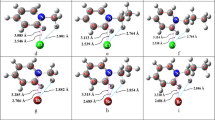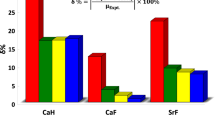Abstract
(DMF)2(HCl)3 and (DMF)2(HCl)4 heterocomplexes were studied for the first time in terms of the B3LYP/6-31++G(d, p) density functional calculation. The resulting data about their structure, stability, strength of intermolecular bonds, and degree of proton transfer in O...H...Cl bridges are compared with the results of a similar calculation fulfilled for (DMF)m(HCl)n clusters (m, n = 1–2) and with the experimental data on the structure and properties of acid-base complexes in DMF solutions of HCl. An extremely stable symmetrical cycle of four molecules — (DMF)2(HCl)2 — is assumed to be a structure-forming element of solution in the DMF-HCl system in the range of concentrations achievable under normal conditions. When [HCl]0 > [DMF]0, the “excess” hydrogen chloride molecules add to the chlorine atoms of this cycle, forming heterocomplexes with a branched structure. Addition of more HCl molecules to the (DMF)2(HCl)2 cycle appreciably increases the degree of proton transfer from acid to base molecule.
Similar content being viewed by others
References
L. F. De Buyck, Janssen Chim. Acta, 6, No. 3, 29–31 (1988).
O. N. Temkin, G. K. Shestakov, and Yu. A. Treger, Acetylene: Chemistry, Reaction Mechanisms, and Technology [Russian translation], Khimiya, Moscow (1991).
S. A. Panova, G. K. Shestakov, and O. N. Temkin, J. Chem. Soc., Chem. Commun., No. 8, 977–982 (1994).
V. D. Mayorov, S. G. Sysoeva, O. N. Temkin, and I. S. Kislina, Izv. Ross. Akad. Nauk, Ser. Khim., No. 9, 1577–1582 (1993).
V. V. Burdin, I. S. Kislina, V. D. Mayorov, and N. B. Librovich, ibid., No. 1, 48–51 (1998).
I. S. Kislina, S. G. Sysoeva, N. B. Librovich, et al., Dokl. Ross. Akad. Nauk, 360, No. 5, 649–651 (1998).
G. V. Yukhnevich, E. G. Tarakanova, V. D. Mayorov, and N. B. Librovich, Usp. Khim., 64, No. 10, 963–974 (1995).
I. S. Kislina, S. G. Sysoeva, and O. N. Temkin, Izv. Ross. Akad. Nauk, Ser. Khim., No. 6, 1025–1027 (1994).
E. G. Tarakanova, O. Yu. Tsoi, G. V. Yukhnevich, et al., Kinet. Kataliz, 45, No. 3, 385–392 (2004).
M. J. Frisch, G. W. Trucks, H. B. Schlegel, et al., GAUSSIAN-94, Revision B.3, Gaussian, Inc., Pittsburg, PA (1995).
E. Benedetti, B. Blasio, and P. Baine, J. Chem. Soc., Perkin Trans. 2, 500–502 (1980).
Author information
Authors and Affiliations
Additional information
Original Russian Text Copyright © 2005 by G. V. Yukhnevich, E. G. Tarakanova, O. J. Tsoy, N. B. Librovich, and I. S. Kislina
__________
Translated from Zhurnal Strukturnoi Khimii, Vol. 46, No. 1, pp. 18–25, January–February, 2005.
Rights and permissions
About this article
Cite this article
Yukhnevich, G.V., Tarakanova, E.G., Tsoy, O.J. et al. Structure of (DMF)m(HCl)n complexes (m= 2, n = 3–4). J Struct Chem 46, 16–22 (2005). https://doi.org/10.1007/s10947-006-0003-7
Received:
Issue Date:
DOI: https://doi.org/10.1007/s10947-006-0003-7




